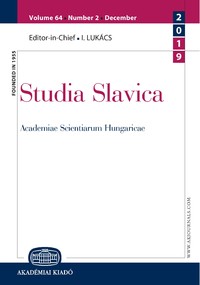Церковнослов’янська лексика зі семантикою ‘Бог; Божа особа’ у староукраїнських текстах
Church Slavonic Lexemes Meaning ‘God; God’s Face’ in Old Ukrainian Texts
Author(s): Yuriy OsinchukSubject(s): Eastern Slavic Languages
Published by: Akadémiai Kiadó
Keywords: historical linguistics; semantics; Old Ukrainian texts; Church Slavonic lexical elements; borrowings; semantic loans from Greek; God; Lord
Summary/Abstract: The present paper is based on materials of different genres and different styles of Ukrai- nian written monuments of the 16th and the 17th centuries (acts, court documents, wills, deeds, documents of church and school fraternities, chronicles, works of religious, polemi- cal and fiction, memos of scientific and educational literature, liturgical literature, episto- lary heritage, etc.) which are included in the source database of the Dictionary of Ukrainian language of the 16th century and the first half of the 17th century and its unique lexical card index, which is stored at the Ukrainian Language Department in the I. Krypiakevych Institute of Ukrainian Studies of the National Academy of Sciences of Ukraine (Lviv). The composition and structural organization of Church Slavonic lexemes meaning ‘God; God’s face’ as well as their origin and history are studied. It was found that the register of this vocabulary included more than fifty phonetic and graphic Church Slavonic elements expressing the concept of ‘God; God’s face’ different in word-forming structure. The main attention is paid to the etymological analysis of the studied tokens, which was primarily to clarify their semantic etymon. It is established that the analyzed Church Slavonicisms are mostly semantic loans from the Greek language, which preserved their semantics from ancient times to the Old Ukrainian period. It is observed that some studied tokens often act as core components of various two-, three-, or four-membered lexicalized phrases. The most active multifunctional core com- ponent was the token Lord. It is established that fixed phrases and phraseologisms are of different types in structure, mostly two-component noun + adjective phrases (sporadically, there are other lexical-grammatical models, too: “noun + noun”, “preposition + adjective”). Much less observable are three-component formations (“noun + verb + pronoun“, “verb + pronoun + noun“) and four-component models (“verb + preposition + pronoun + noun”). It was found that the Church Slavonic words attested in the Ukrainian memos of the 16th and the 17th centuries did not undergo significant semantic changes in the process of formation of religious vocabulary. Some Church Slavonicisms have gone through a partial semantic modification, and some have acquired new semantics due to fixed phrases. Some words that point to God’s face are characterized by polysemy and synonymy. The evolution of the analyzed Church Slavonicisms is different. Some of them have survived to our time and are actively used in the Ukrainian literary language or dialects, while others function only in a special area: in the church practice of the Byzantine rite (Orthodox Church of Ukraine, Ukrainian Greek Catholic Church).
Journal: Studia Slavica Academiae Scientiarum Hungaricae
- Issue Year: 64/2019
- Issue No: 2
- Page Range: 383-396
- Page Count: 14
- Language: Ukrainian
- Content File-PDF

